Protesters turned Hong Kong into a tinderbox. But it's the government that holds the matches
The young protesters who have thronged Hong Kong's streets for three months warned the city's leaders from the beginning: "If we burn, you burn with us."
That threat seemed all the more real on Saturday, as black smoke poured into the sky from a huge bonfire set by protesters following violent clashes with police outside the city's legislature. Petrol bombs and bricks were thrown during that standoff, as police replied by firing a water cannon and round after round of tear gas.
Violence continued late into the night, as police officers surrounded by protesters let off warning shots and riot cops were later seen charging into a subway station and attacking alleged protesters on a train. On Sunday, it was protesters who targeted the subway, shutting down and vandalizing several stations after an hours-long standoff which paralyzed transport to and from the city's airport.
As the violence continues to escalate, Hong Kong's leaders have made clear they will not negotiate on any of the movement's key demands, despite calling for "dialogue."
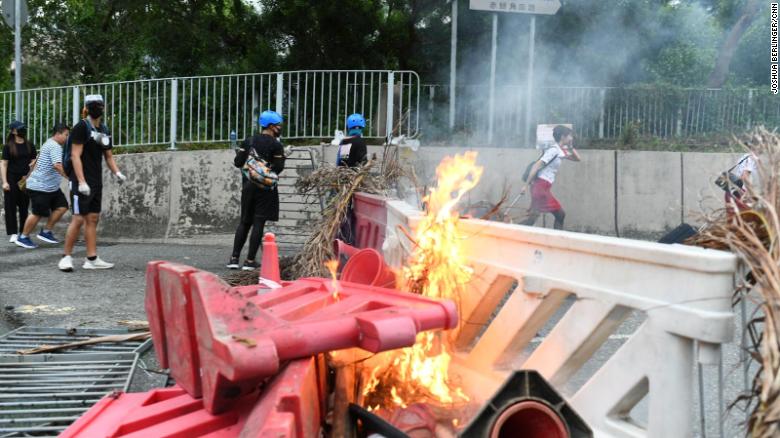
A flight attendant sprints past a burning barricade in Tung Chung on the way to Hong Kong international airport during protests on September 1, 2019.
The government's message to protesters seems to be go home empty-handed or risk a major crackdown -- which, at its most extreme, could involve the military.
But there are signs that gamble could backfire. Protesters have shown no hesitation to causing disruption to the city's economy and daily life.
As the mood becomes more nihilistic and angry, some may even welcome a crackdown.
The mood is shifting
The past week has seen a clear escalation in how the authorities handled the protests.
On Friday, several leading pro-democracy activists and politicians were arrested and charged with a variety of offenses, including the vaguely worded "Inciting others to participate in an unlawful assembly," which carries a maximum five-year jail term, in what appears to have been an attempt to fulfill an impossible task, taking the head off a leaderless movement.
Also on Friday, a rally and march planned by the Civil Human Rights Front (CHRF), the group which arranged previous mass peaceful protests attended by hundreds of thousands of people, was banned by police. Although CHRF represents the moderate, non-violent wing of the protests, and has demonstrated support from a broad swath of Hong Kong society, police had no intention of risking an escalation.
That escalation came regardless. Demonstrators took to the streets on Saturday in wildcat demonstrations that eventually coalesced around the legislature, where an hours-long battle broke out between more extreme protesters and police, and spread to other parts of the city. Protesters threw petrol bombs and bricks at police, and aimed laser pointers at them.
Here again, police tactics were noticeably harsher than in earlier days of protests. They repeatedly use water cannon, only the second occasion this summer, and deployed hundreds of officers to the streets, charging protester lines and carrying out dozens of arrests.
The water cannon fired blue dye, which typically leaves a residual stain making it easier to identify participants for arrest later.
Ordered in 2015, police had resisted using water cannon for nearly three months. Now that tool has been deployed from their arsenal, it has quickly become normalized. Protesters are adapting just as quickly, sharing information online on how to get rid of the blue stains.
As both police and protesters continue to escalate their tactics with no sign of the unrest halting, fears grow that the government will turn to the Chinese military for support in putting the protests down.
Last week, thousands of new troops from the Chinese People's Liberation Army (PLA) joined the garrison in the city. The PLA described it as a usual annual rotation of staff, but US military officials told CNN they had seen no evidence that existing forces left the garrison, and suggested it instead may have been significantly reinforced.
Around the same time, Hong Kong's leader Carrie Lam also refused to rule out instituting the Emergency Regulations Ordinance to tackle the protests. The colonial era bill would allow her to "make any regulations whatsoever" in an "occasion of emergency or public danger." This could allow for mass arrests, curfews and media or internet censorship.
All eyes will be on Lam this week to see if she institutes such powers -- or if she asks the PLA garrison for assistance in controlling the protests.
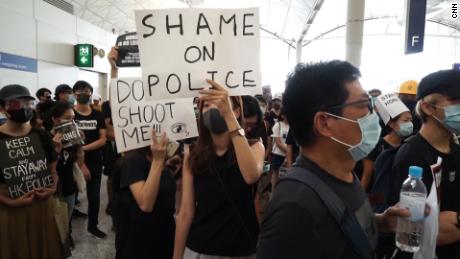
Play Video
Hong Kong protests hit low-income workers hard 02:25
HK officials stalling, or powerless to act
As the smoke and tear gas clears after the weekend's violence, escalation on both sides appears to be the only thing on the cards.
While Lam has made gestures towards meeting with young people, and potentially with protester representatives, she has also repeatedly refused to negotiate when it comes to the opposition movement's five core demands. These include a complete withdrawal of the currently suspended extradition bill that kicked off this whole mess, an independent investigation into allegations of police brutality, and the restarting of long-stalled political reform.
Saturday's protests marked five years since Beijing ruled out true universal suffrage for how the city's chief executive is chosen. In the type of tin-eared statement that has characterized the Hong Kong government's response to the crisis, a city spokesman said Saturday -- to the rage of many already on the streets -- that "rashly embarking on political reform again will further polarize society, which is an irresponsible act."
The government is offering protesters few choices. They can go home and pin their hopes on a vague promise of future negotiations once the violence has stopped, or continue protesting until the government cracks down.
Hong Kong officials may not be the ones choosing this strategy -- Reuters reported last week that Lam suggested a compromise in August but was overruled by Beijing -- but they do not have the cards to risk such a bluff. Lam had apparently mooted a withdrawal of the extradition bill in order to defuse the crisis, but Beijing ordered a hard line.
CNN has reached out to the Hong Kong-Macao Affairs Office and the Office of Chief Executive Carrie Lam for comment on the Reuters report. China's foreign ministry on Friday reiterated that the central government "supports, respects and understands" the Hong Kong government's position on protester demands.
In a strident commentary Sunday, Chinese state news agency Xinhua said that "violence in Hong Kong must end now."
The Hong Kong government and police "took decisive measures to enforce the law and stop the violence, sending a clear warning to the rioters," Xinhua said. "The end is coming for those attempting to disrupt Hong Kong and antagonize China."
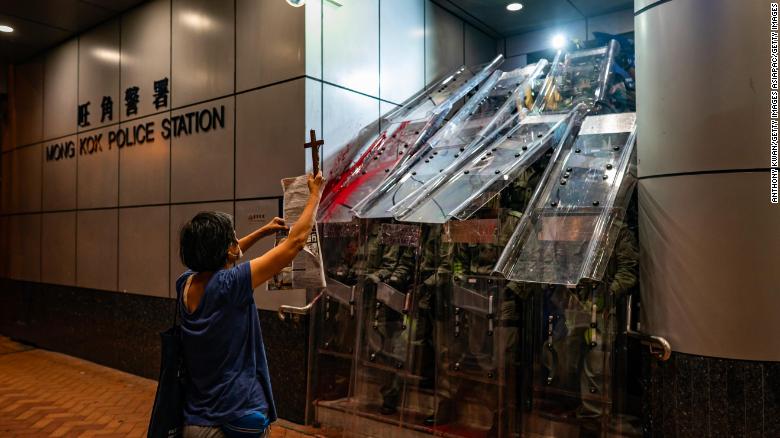
A woman holds a cross in front of the Mongkok Police Station as riot police holding shields stand guard during a standoff with protesters after an anti-government rally in on September 1, 2019, in Hong Kong.
What a crackdown might look like
The PLA has had a presence in Hong Kong since the 1997 handover from British control, but has remained very much in the background in a city where a large memorial for the Tiananmen Square massacre is held each year.
The sight of PLA troops patrolling Hong Kong's streets, let alone using force, has long been feared as a symbolic point of no return for the city.
The Tiananmen parallels would be hard to avoid even in a peaceful operation, and analysts agree that it would risk crashing the city's economy, sending foreign firms and investors scrambling for the exits. Censorship of local media or the internet could have a similar effect.
Who would be the most hurt by this? Probably not the young people who make up the most radical, violent core of the protests. For many of them, a future under full Chinese rule -- approaching fast in 2047 under current constitutional arrangements -- is a hopeless prospect.
Already at the sharp end of Hong Kong's horrendous economic inequality and unfair housing system, they are also less concerned about inflicting economic damage. Nothing has hurt the city's global standing more than protests at the airport, but radical groups have continued to target it, seeing it as a weak point to exploit and one that draws significant international attention.
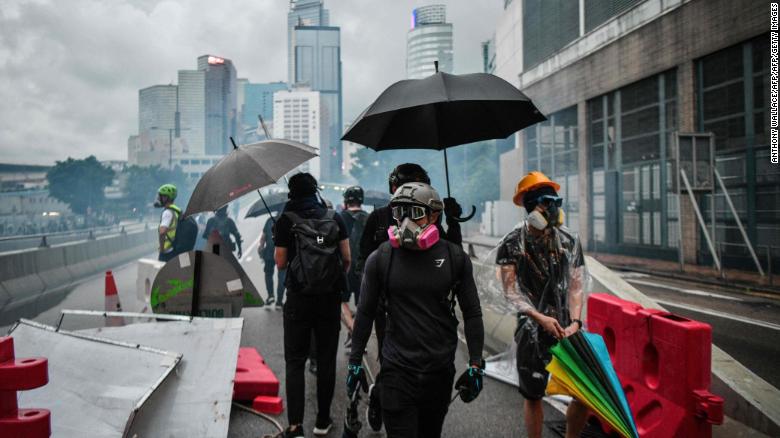
Protesters gather on a road as police fire tear gas outside the government headquarters in Hong Kong on August 31, 2019.
Hardcore protesters sometimes appear to relish the thought of PLA troops on the streets, seeing it as proof of their ability to shake the foundation of not only the Hong Kong government but also the powers in Beijing.
"Good! We are ready for it, we want it!" protesters told CNN during ugly scenes of mob violenceat the city's airport last month, when asked about what could happen in the event of a PLA crackdown.
"Give me liberty or give me death," read graffiti left by protesters after more chaotic scenes near the airport on Sunday.
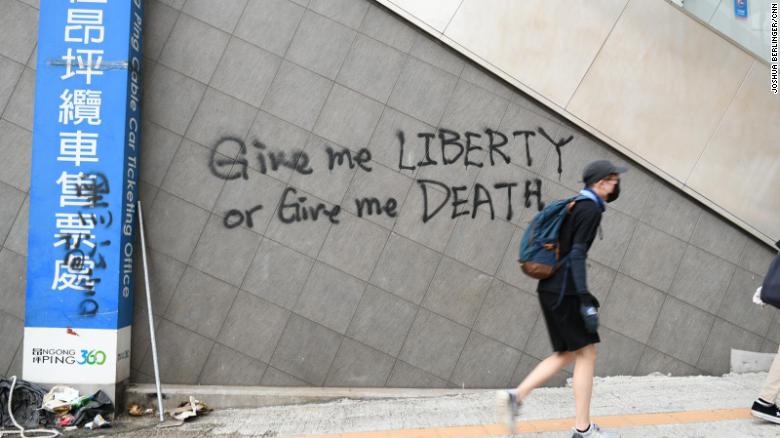
Graffiti on a wall in Tung Chung, where protesters fled after disrupting transport to and from Hong Kong airport.
Whether Lam can handle the repercussions of a decision to clamp down militarily is much less clear. Any local support she has comes from the city's elite, the tycoons who profited off the city's yawning inequality and huge influx of Chinese capital, and have kept their noses out of the city's current political crisis.
Should PLA troops be deployed to help secure the city -- or, worse, a full-scale military crackdown ordered -- she would be immortalized as the figurehead of that decision: the chief executive who oversaw the worst crisis in Hong Kong's history -- and did not act to stop it.
Beijing may already be risking economic and societal damage by maintaining its uncompromising stance. The Chinese economy is facing a multitude of challenges -- weak growth, high levels of debt, and, of course, the ongoing trade war with the US. Economic collapse, or even the slowdown of Hong Kong, could have knock-on effects north of the border, ones that could quickly spin out of Beijing's control.
In a statement Sunday calling for a general strike, the Hong Kong Confederation of Trade Unions blamed the ongoing crisis squarely on the government. "We must save Hong Kong from institutional collapse," the group warned. "Hong Kong is our beloved home; our jobs, livelihoods, family, and friends that we cherish are all here. We cannot let those who are in power continue to ravage the home that we always hold dear."
If the increasingly violent protesters are the ones who have turned Hong Kong into a tinderbox, it's the government holding the matches. One wrong move now could see the whole city burn.
News Courtesy: www.cnn.com











